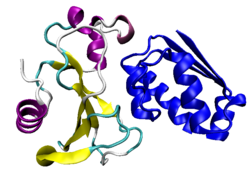- Multiprotein complex
-
A multiprotein complex (or protein complex) is a group of two or more associated polypeptide chains. If the different polypeptide chains contain different protein domain, the resulting multiprotein complex can have multiple catalytic functions. This is distinct from a multienzyme polypeptide, in which multiple catalyic domains are found in a single polypeptide chain.[1]
Protein complexes are a form of quaternary structure. Proteins in a protein complex are linked by non-covalent protein–protein interactions, and different protein complexes have different degrees of stability over time. These complexes are a cornerstone of many (if not most) biological processes and together they form various types of molecular machinery that perform a vast array of biological functions. Increasingly, scientists view the cell as composed of modular supramolecular complexes, each of which performs an independent, discrete biological function.[2] By existing in proximity, the speed and selectivity of binding interactions between enzymatic complex and substrates can be vastly improved, leading to higher cellular efficiency. Unfortunately, many of the techniques used to break open cells and isolate proteins are inherently disruptive to such large complexes, so their protein complexes within the cell may be even more widespread than can be detected. Examples include the proteasome for molecular degradation, the metabolon for oxidative energy generation, and the ribosome for protein sythesis. In stable complexes, large hydrophobic interfaces between proteins typically bury surface areas larger than 2500 square angstroms.[3]
However, complexes need not be stable. Understanding the functional interactions of proteins is an important research focus in biochemistry and cell biology. Protein complex formation sometimes serves to activate or inhibit one or more of the complex members and in this way, protein complex formation can be similar to phosphorylation. Individual proteins can participate in the formation of a variety of different protein complexes. Different complexes perform different functions, and the same complex can perform very different functions that depend on a variety of factors. Some of these factors are:
- Which cellular compartment the complex exists in when it is contained
- Which stage in the cell cycle the complexes are present
- The nutritional status of the cell
- Others
Many protein complexes are well understood, particularly in the model organism Saccharomyces cerevisiae (a strain of yeast). For this relatively simple organism, the study of protein complexes is now being performed genome wide and the elucidation of most protein complexes of the yeast is undergoing.
The molecular structure of protein complexes can be determined by experimental techniques such as X-ray crystallography or nuclear magnetic resonance. Increasingly the theoretical option of protein–protein docking is also becoming available. One method that is commonly used for identifying the members of protein complexes is immunoprecipitation.
Homomultimeric and heteromultimeric proteins
The subunits of a multimeric protein may be identical as in a homomultimeric protein or different as in a heteromultimeric protein.
The voltage-gated potassium channels in the plasma membrane of a neuron are heteromultimeric proteins composed of four of forty known alpha subunits. Subunits must be of the same subfamily to form the multimeric protein channel. The tertiary structure of the channel allows ions to flow through the hydrophobic plasma membrane. Connexons are an example of a homomultimeric protein composed of six identical connexins. A cluster of connexons forms the gap-junction in two neurons that transmit signals through an electrical synapse.
References
- ^ Price, N. C., and L. Stevens. 1999, Fundamentals of enzymology: The cell and molecular biology of catalytic proteins. New York, Oxford University Press.
- ^ Hartwell, L.H.; Hopfield, J.J.; Liebler, S.; Murray, A. W. 1999. From molecular to modular cell biology. Nature 402 (6761): C47-C52.
- ^ Pereira-Leal,J.B.; Levy,E.D.; and Teichmann, S.A. 2006, The origins and evolution of functional modules: lessons from protein complexes. Philos Trans R Soc Lond B Biol Sci. 2006 March 29; 361(1467): 507–517. doi: 10.1098/rstb.2005.1807.
External links
Categories:- Protein complexes
Wikimedia Foundation. 2010.

